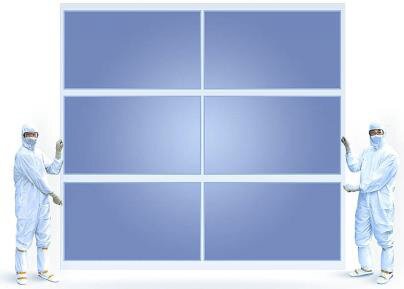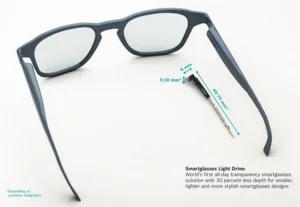Yesterday was the easier part of my two part look back and forward, by a decade, at the display industry (Looking a decade back….). Looking forward, as Niels Bohr said, “it’s difficult to predict, especially the future”. However, there are some very high level trends, and I’m going to rely on my multiple decades (too many!) in the display industry to inform my thoughts.

Looking ahead as far as a decade allows me to ignore individual companies and particular specialist technologies. There are some trends that will, I am certain, continue.
The first is increasing spatial resolution. I wrote a Display Daily a year or so ago that explained why higher resolution, colour depth, dynamic range and brightness will continue to improve in pretty well all display applications. I’m currently party to a lively email argument about whether 8K makes any sense for TV. It does, although better frame rates, colour and dynamic range would be more efficient ways to deliver a better TV experience. We are getting closer to ‘diminishing returns’, but we haven’t reached the end of the line, and we won’t have in a decade.
As I have also written in the past, 8K is going to happen because, for LCD makers, “pixels are more or less free”, as David Barnes used to say. (8K is Closer than You Think). I have no doubt, at all, that 8K will be the dominant TV set format by the end of 2029. Whether it will be the dominant content format by then is more contentious*, but the displays will certainly be there.
(*if nothing else, the optics to support 8K content are a real challenge in technology and cost and there is no Moore’s Law for optics)
If I think about the dominant display technology in 2029, that’s a bit trickier. LCD has a vast advantage because of the decades of massive investment which have reduced the costs of producing LCDs to levels that were unimaginable twenty years ago. Any competing technology has to not only be better in performance, it has to be possible to make it in factories that will have to compete with the large number of LCD fabs that will have had their investment costs written off. In the past, there was a chance to become more competitive by making substrates larger and larger, but it’s hard to see that trend continuing – we seemed to have really reached the limits of the ‘Generation Game’. However, I remember going to a talk some fifteen or twenty years ago that summarised very clearly why anything beyond G6 was never going to happen!
MicroLED and electroluminescent QDs (ELQDs) look like very good prospects as challengers for the best display technology by 2029. They are both emissive, and it seems inevitable that an emissive technology will eventually squeeze out the transmissive approach of LCD. Efficiency of converting electrons to photons is likely to be a key advantage.
However, to compete they will have to have large area, low cost active matrix backplanes, like LCDs. Maybe somebody will come up with a cheaper way of controlling the pixels, but I wouldn’t bet on it. The real question, to me, is whether you can make these backplanes more efficiently and cost effectively than the current glass substrate-based approach. That means, probably, either some kind of ‘roll-to-roll’ (R2R) process, or an inkjet style or additive 3D printing process that can build those substrates. I wouldn’t bet against glass still being the best material for the backplane, although it is likely to be thinner, tougher and more flexible than the glass used today.
 LCD generations are unlikely to go much beyond G10.5 – shown here with six 75″ panels. Image:Corning
LCD generations are unlikely to go much beyond G10.5 – shown here with six 75″ panels. Image:Corning
If emissive materials are the winners, OLED is, of course, the current incumbent. To see off competition from microLED and ELQDs, I think there has to be a breakthrough in blue materials. Without that, I see the OLED makers using the sophisticated backplanes from that technology, but with more efficient and longer lasting materials. We have, of course, been waiting a couple of decades for such a breakthrough, already. (although I have also learned, over the years not to ‘bet against the engineers’ and the story of the blue LED and Shuji Nakamura is always a reminder of this).
Those conclusions really apply to the mass device market for direct view displays from smartphones to around 100″. Above that, LED will still be dominant and although prices will come down, and performance still continue to improve, I suspect that the change will be evolutionary, rather than revolutionary. If R2R did become possible, that could change things, but otherwise it will be ‘more of the same’. Projection will probably still be around, but will be a niche product, I think. There is a good chance (a probability, I think) that many of the best cinemas will use direct view LED displays.
The really revolutionary display device development will be, I think, in ‘near to eye’ displays. Let’s say XR. I was recently very impressed with the mixed reality experience I had with the Varjo headset (Varjo Impresses with Mixed Reality). However, to make mixed reality work, you need the full ‘goggles’ experience and that form factor is going to limit the scope of that approach in consumer markets, beyond gaming. It still seems to me that AR with ‘spectacles-like’ form factors as the real breakthrough that might have the same impact on behaviour and devices as the smartphone. That’s still going to take some time, but, given what I have already seen, I’m sure that by 2029, smartglasses will be as ubiquitous as smartphones are now.
Bosch will be showing what it is doing in smartglasses at CES. Image:Bosch
Smartphones will still be around, of course, but many or most will be foldable and flexible. The road to developing the reliability and functionality that will enable high volume consumer products has been a long and tough one, but we are now at the starting gate for mass use. Foldable devices will blur the lines between current categories such as smartphones, tablets and notebooks. Will there be a completely new category? I’m not sure – the idea of smartphones and tablets had been around a very long time before the technology and pricing came together to enable mass adoption.
I should also mention desktop monitors. I don’t think they will change dramatically, but there will be more bigger, wider and curved displays. After all, as Dr Jon Peddie always says, “The more you can see, the more you can do”. (BR)

